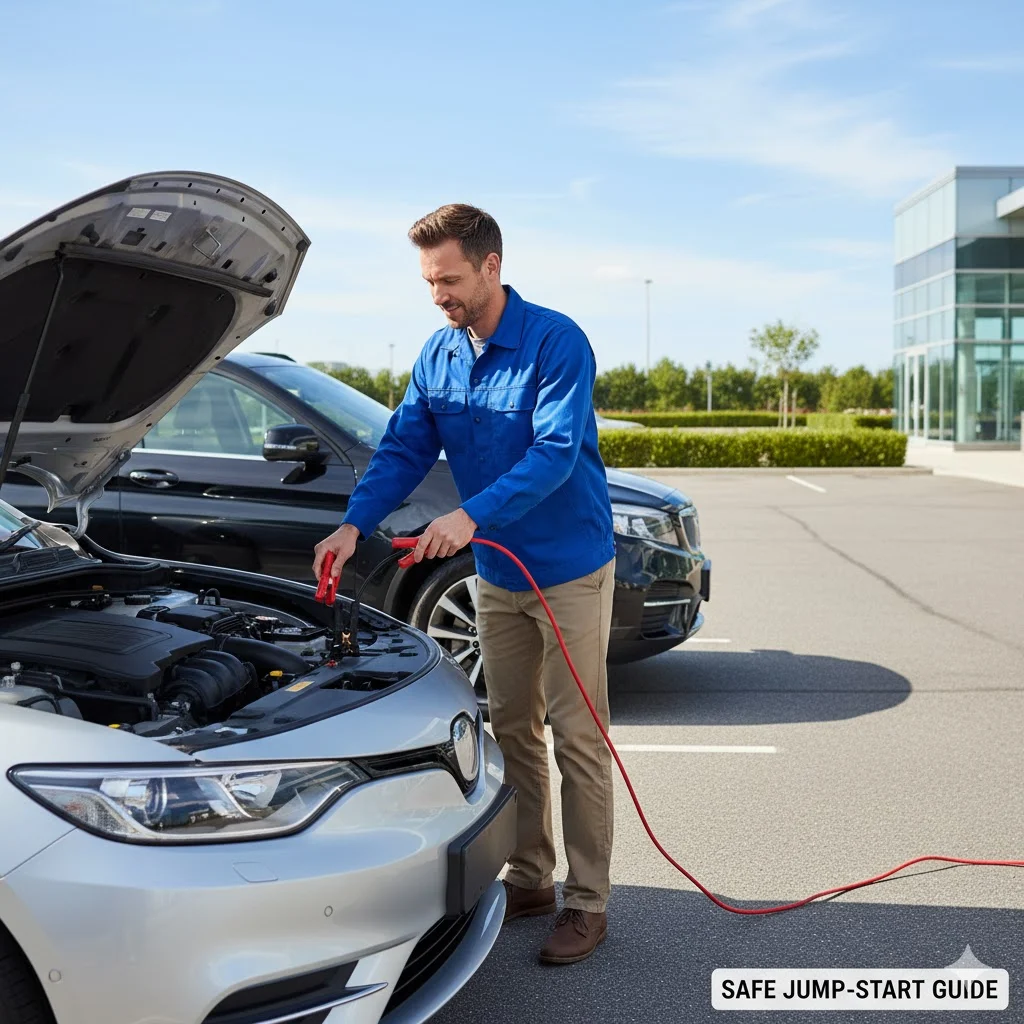It’s early morning. You’re ready for work. You sit in your car, turn the key… and nothing happens. No sound. No lights. Just silence. 😩
This means your car battery is dead — and while that sounds stressful, it’s one of the easiest car problems you can fix on your own.
This complete guide will teach you how to jump start your car safely and correctly, even if you’ve never touched jumper cables before. You’ll learn:
- What tools you need
- Exact step-by-step instructions
- Safety precautions (to avoid sparks or damage)
- What to do if it still won’t start
- FAQs and battery maintenance tips
By the end, you’ll not only have your car running — you’ll also feel more confident in handling roadside emergencies like a pro.
⚙️ What Causes a Dead Battery?
Before learning how to jump start a car, it helps to know why batteries die in the first place.
A car battery may go flat due to:
- Leaving lights or electronics on overnight 🕯️
- Cold weather, which slows the chemical reaction inside the battery ❄️
- Loose or corroded battery terminals ⚡
- Old age — most car batteries last 3–5 years
- Faulty alternator (the part that recharges the battery while driving)
- Long periods of inactivity — your battery slowly drains if your car sits too long
Knowing these causes helps you prevent it from happening again later.

🧰 What You’ll Need to Jump Start a Car
Before doing anything, gather these items:
- A working vehicle with a fully charged battery
- Jumper cables (4-gauge or thicker preferred)
- Safety gloves and goggles (for protection from sparks)
- Owner’s manual (check for battery-specific instructions)
💡 Pro Tip: Always keep a portable jump starter in your car trunk.
It’s a small, battery-powered device that can boost your car without needing another vehicle — perfect for emergencies or when you’re alone.

🪫 Step-by-Step: How to Jump Start a Car (Safely)

Here’s the complete process, broken down clearly and safely.
✅ Step 1: Park Both Cars Correctly
- Position the cars — park them close enough for the cables to reach, but make sure they’re not touching.
- Turn off both ignitions and remove the keys.
- Engage the parking brakes on both vehicles.
- Switch off all lights, radios, and accessories.
🔒 This prevents electrical surges when connecting the cables.
✅ Step 2: Locate and Identify Battery Terminals
Open both hoods and find the car batteries. You’ll see two terminals:
- Positive (+) — often red, sometimes covered with a plastic cap.
- Negative (–) — usually black and attached to the car body or frame.
🧼 If you see white or green corrosion, clean it off with a dry cloth or wire brush before proceeding.
✅ Step 3: Connect the Jumper Cables (In the Right Order)
This is the most important part — follow it exactly to avoid sparks or short circuits.
- Red to Dead: Attach one red clamp to the positive (+) terminal of the dead battery.
- Red to Donor: Attach the other red clamp to the positive (+) terminal of the good battery.
- Black to Donor: Attach one black clamp to the negative (–) terminal of the good battery.
- Black to Ground: Attach the other black clamp to an unpainted metal part of the dead car (like a bolt or bracket).
⚠️ Never attach the last black clamp directly to the dead battery — it may cause sparks or even battery explosion due to hydrogen gas.
✅ Step 4: Start the Working Vehicle
Start the car with the good battery first and let it idle for 2–3 minutes.
This allows some charge to transfer into the dead battery.
You might notice headlights brighten or engine RPM slightly drop — that’s normal.
✅ Step 5: Start the Dead Car
After a few minutes, try starting the car with the dead battery.
- If it starts immediately, great!
- If not, wait 2–3 more minutes and try again.
Once the dead car starts, keep both cars running for 5 minutes to stabilize the charge.
✅ Step 6: Disconnect the Cables (Reverse Order)
Disconnect the jumper cables in the reverse sequence you connected them:
- Remove black clamp from the metal surface of the previously dead car.
- Remove black clamp from the good battery.
- Remove red clamp from the good battery.
- Remove red clamp from the previously dead battery.
Be careful not to let clamps touch each other or any metal part while removing them.
✅ Step 7: Let the Engine Run
Let the jumped car idle for at least 20–30 minutes before turning it off.
This helps the alternator fully recharge the battery.
🚘 Optional: Drive around for 15–20 minutes — idling charges slowly, while driving boosts faster.
If your car dies again shortly after, it’s likely time for a battery replacement or alternator check.
⚡ Common Jump-Starting Mistakes to Avoid
Jump-starting is simple, but even one wrong step can damage your car. Avoid these common errors:
- ❌ Reversing the clamps (mixing up positive and negative)
- ❌ Touching clamps together after connection
- ❌ Skipping ground connection — always attach black to metal, not battery
- ❌ Starting both cars too soon
- ❌ Leaving cables attached after both cars are running
- ❌ Attempting to jump a leaking, cracked, or frozen battery
🔥 Pro Tip: If the battery case is swollen, cracked, or smells like rotten eggs — don’t jump start it. It could explode.

🔍 Troubleshooting: When Jump Starting Doesn’t Work

If your car still refuses to start after several attempts, check these possible issues:
| Problem | Symptom | Solution |
|---|---|---|
| Corroded battery terminals | White crust or residue | Clean terminals and try again |
| Faulty jumper cables | No spark, thin or cheap wires | Use thick, quality cables |
| Bad alternator | Car dies again after running | Have it checked by a mechanic |
| Completely dead battery | Car won’t start at all | Replace the battery |
| Starter issue | Clicking sound, no crank | Call roadside assistance |
💬 If you hear a clicking sound when turning the key, the starter or solenoid may be bad. If there’s no sound, it’s likely a dead battery or loose cable.
🧠 Pro Tips for Car Battery Maintenance

To avoid dealing with a dead battery again, follow these maintenance tips:
- Drive your car regularly. Short trips may not fully recharge the battery.
- Turn off all lights and accessories before leaving your car.
- Clean terminals monthly to prevent corrosion.
- Check battery voltage — a healthy battery reads 12.6V when off and 13.7–14.7V when running.
- Replace the battery every 3–5 years.
🧾 Keep a battery health log — many mechanics offer free checks during oil changes.
💬 FAQs — Jump Starting a Car
Q1: Can I jump start a car alone?
✅ Yes. Use a portable jump starter — connect red to positive (+), black to ground, then press the power button.
Q2: How long should jumper cables stay connected?
⏱ About 2–5 minutes after starting the donor car before attempting to start the dead one.
Q3: Is it dangerous to jump start a frozen battery?
⚠️ Yes! A frozen battery can explode. Let it thaw completely before jump starting.
Q4: What happens if you connect cables backward?
🚫 It can fry your electrical system, damage the alternator, or blow fuses. Always double-check polarity.
Q5: Can a completely dead battery be recharged?
🔋 If the battery isn’t damaged, yes — after jump starting, drive for 30+ minutes or use a battery charger.
Q6: When should I replace my car battery?
🧾 Most batteries last 3–5 years, depending on weather, brand, and driving habits.
🏁 Final Thoughts
Learning how to jump start a car is one of the most valuable skills every driver should have.
It’s quick, safe, and saves you the frustration of waiting hours for roadside help.
Just remember the golden rule:
👉 Red to Red, Black to Metal, and Patience Wins Every Time.
Stay prepared — keep quality jumper cables or a portable starter in your trunk, and you’ll never be stranded again.




